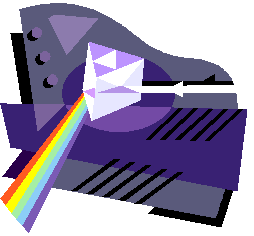
White light is made up of seven colours;
RED, ORANGE, YELLOW, GREEN, BLUE, INDIGO, VIOLET.
The splitting of white light into its constituent colours is called dispersion. Each colour has a different wavelength, red having the longest wavelength and violet with the shortest wavelength.

When white light is dispersed the seven colours of the spectrum are obtained. When the light of these seven colours is combined white light is produced.
However, it is not necessary to combine all seven colours to get white light. Three certain colours will also produce white light. These are know as the Primary Colours and they are RED, GREEN and BLUE.
A secondary colour is produced from mixing two primary colours together.
|
Red & Green = Yellow |
|
|
Red & Blue = Magenta |
|
|
Green & Blue = Cyan |
Complementary colours are two colours which when mixed together give white light.
|
Yellow & Blue = White light |
|
|
Magenta & Green = White light |
|
|
Cyan & Red = White light |
Colour Image Analysis
Human colour perception is psycho-physical and is not fully understood. There is a consideration of physics involved. Physics can explain how our eyes receive the particular wavelengths that we associate with a certain name.
Human Perception of Colour
Below is a table of the changes in the human perception of colours resulting from various diseases and chemical substances:
| Disease or Chemical | Change in Colour Perception |
| Alcoholism | Blue Defect |
| Brain tumour, trauma | Red-green or blue-yellow defects |
| Malnutrition | All colours defected |
| Multiple Sclerosis | Red-yellow defects |
| Caffeine | Enhances red sensitivity & reduces blue |
| Tobacco | Red-green defect |